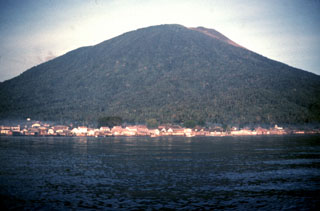Report on Gamalama (Indonesia) — July 1994
Bulletin of the Global Volcanism Network, vol. 19, no. 7 (July 1994)
Managing Editor: Richard Wunderman.
Gamalama (Indonesia) Eruptions generate ash cloud to ~5 km altitude and cause ashfall
Please cite this report as:
Global Volcanism Program, 1994. Report on Gamalama (Indonesia) (Wunderman, R., ed.). Bulletin of the Global Volcanism Network, 19:7. Smithsonian Institution. https://doi.org/10.5479/si.GVP.BGVN199407-268060
Gamalama
Indonesia
0.81°N, 127.3322°E; summit elev. 1714 m
All times are local (unless otherwise noted)
A NOTAM that originated from the Ujung Pandang FIR on 6 May 1994 requested that all aircraft avoid the area around Gamalama volcano. VSI did not note any unusual activity on that day, and no ash cloud was detected on satellite imagery. The warning only noted that the height of "dust" was variable.
Members of the SVE visited Gamalama at 1130 on 21 July. Summit activity consisted of violent degassing from the summit crater, producing a white-gray plume above the volcano; no solid material was ejected during the observations. A small active fumarolic area on the W crater rim exhibited yellow sulfur deposits. White vapor was rising from a large crack on the E crater rim, a part of the crater that appeared to be very unstable. The bottom of the crater could not be seen from the rim.
VSI reported that activity from the main crater increased with a sudden eruption on 5 August 1994 at 2125. The eruption produced an ash cloud to a height of 3,000 m above the summit . . . and accompanying ash falls. A felt earthquake a few minutes before the eruption had an intensity of MM II-III. Volcanic tremor recorded since 10 August preceded another eruption at about 2400 on 13 August from the same location. A news report indicated that explosions on 14 August caused ashfall in Ternate (~ 4 km SE), and that 5-20 minor explosions/day had occurred in recent days.
Following eruptions in May 1993 (18:5 & 7; and VSI, 1993a), seismicity steadily decreased to low levels by the end of June; vapor emission stopped by the end of August 1993 (VSI, 1993b). Seismicity began increasing again in December 1993 (VSI, 1993b), and explosions were reported during January-March 1994 (19:05).
Geological Summary. Gamalama is a near-conical stratovolcano that comprises the entire island of Ternate off the western coast of Halmahera, and is one of Indonesia's most active volcanoes. The island was a major regional center in the Portuguese and Dutch spice trade for several centuries, which contributed to the extensive documentation of activity. Three cones, progressively younger to the north, form the summit. Several maars and vents define a rift zone, parallel to the Halmahera island arc, that cuts the volcano; the S-flank Ngade maar formed after about 14,500–13,000 cal. BP (Faral et al., 2022). Eruptions, recorded frequently since the 16th century, typically originated from the summit craters, although flank eruptions have occurred in 1763, 1770, 1775, and 1962-63.
Information Contacts: W. Tjetjep, VSI; H. Gaudru, C. Pittet, M. Auber, C. Bopp, and O. Saudan, EVS, Switzerland; BOM Darwin, Australia; AP; Radio Republik Indonesia.

